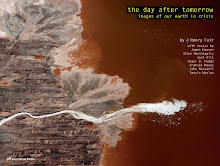This narcissist tendency is perhaps natural in a time when real issues are so murky and insoluble, but the classical concept of art being about the world seems suddenly relevant and necessary. Art should move people, not just be a cascade of insider references. The development of the techniques of manipulating emotions comprises most of the history of art, till the time “art” became precisely the rejection of such techniques.
My work is about creating a sense of irony by utilizing these techniques to make compelling images that have layers of meaning based on contemporary issues.
But narratives are what we crave, the balm for awareness, the explanation of the unknown. As a story-teller, one wants to relate those stories, and this current exhibit at the UmweltBundesAmt (The German Environmental Agency) is just that. For the first time, we assemble maps and satellite views, detailed explanations of the pictures in German and English, and a set of graphic icons that represent the various impacts of the processes.
Assembling all of the components, an old desire, has been several years in the making. The exhibit was born at Natur Museum Südtirol in Bolzano, Italy, but the creation of this extensive appendix was beyond time or budget.
Ideally, the appendix would be web-based, so viewers could browse at any time. One even imagines using QR codes with each image to link directly as the viewer is experiencing the picture. But ushering smart devices into an exhibit is a gift from Pandora, and it’s nice to make it physical, and to separate information from image so viewers must first contemplate. Also nice is to credit the many people who make an exhibit happen, especially one so complex, from pilots to curators and translators.
View of "The Hidden Costs" exhibition at Umweltbundesamt













